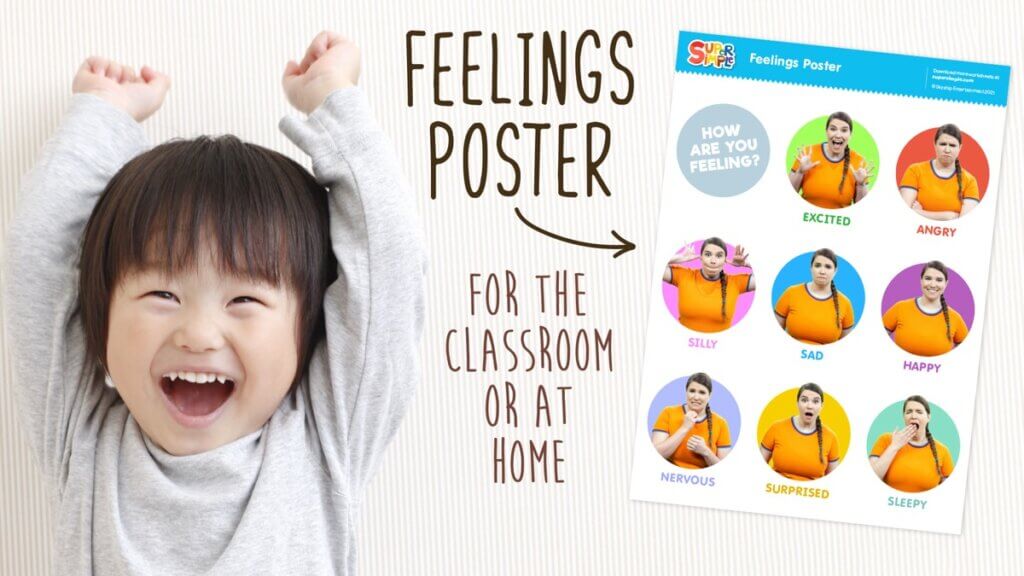
This Feelings Poster is a simple tool that can help teach little ones emotion vocabulary and expression recognition. It can also encourage emotional empathy and self regulation when it comes to all those big feelings. Print out our Super Simple Feelings Chart, post it on a wall in your home or classroom and refer to it often!
Here are some ideas on how to use your new Feelings Poster!
Identify Feelings
This is a great thing to do first thing in the morning to start your day, or whenever little ones might need a check-in. Simply show the chart to your little one and ask them to point to the emotion they are feeling. This is a great way for little ones to consider their emotions, and to start getting comfortable with sharing their feelings.
Feelings Game
This poster helps little ones understand facial expressions as well as emotions vocabulary. Try making a facial expression similar to one of Caitie’s on the poster, and have little ones point to the emotion that matches on the poster. You can also have your little one point to a feeling on the poster and try to make the facial expression themselves. Once your little one is familiar with the feelings on the poster, you can try this game anywhere! Make a facial expression and have your little one guess what emotion you are showing, then switch!
Remembering Feelings
Pick a feeling on the feelings poster and share a story of when you felt that emotion. Encourage little ones to share a time when they felt that way too. This will help little ones to better understand and identify their feelings in the future by thinking about when they felt certain ways in the past.
How Others Might Be Feeling
This is a great way to help little ones understand emotional empathy. If your little one is having a disagreement with another person, bring them to the feelings chart and ask them not only how they are feeling, but how they think the other person might be feeling. To work on emotional empathy on a regular basis, you can make up a story (for example, Teddy lost his favorite toy) or read a storybook and ask your little one to point to the feeling the character might be experiencing. You can also discuss how you might respond empathetically to the situation to help someone feel better.
Coping Skills
Everyone needs to learn healthy ways to process their emotions, and little ones are no different. Try picking a feeling on the Feelings Poster and talk about what behaviours are usually associated with that feeling, or what actions your little one has done when they felt that way. Then consider whether these actions are good or if there is a better way to express them. You can put some boundaries in place for the next time your little one is feeling a big feeling so they know it’s okay to feel that way, but they’ll also have some guidelines for what they can do to feel better. For example, taking some deep breaths or going to a quiet place is a great way to help big feelings from getting even bigger and out of control.
Make Your Own
For a fun activity, you can make your own Feelings Poster with your little one. You can include new feelings or recreate the poster as it is. You can try drawing pictures of the facial expressions, or take photos of your little one like our photos of Caitie!
We hope our Feelings Poster is a helpful tool in your classroom or home! Be sure to place it where you can see it often – this is a great way to remind little ones to think about their feelings and notice how they and others might be feeling throughout the day.
For more activities, songs, and videos about emotions, visit our Emotions theme page.
Don’t forget to follow us on Twitter, Instagram, Pinterest, and Facebook!
Original content © 2021 Super Simple. Not to be reprinted without express written permission. Terms of Service.

